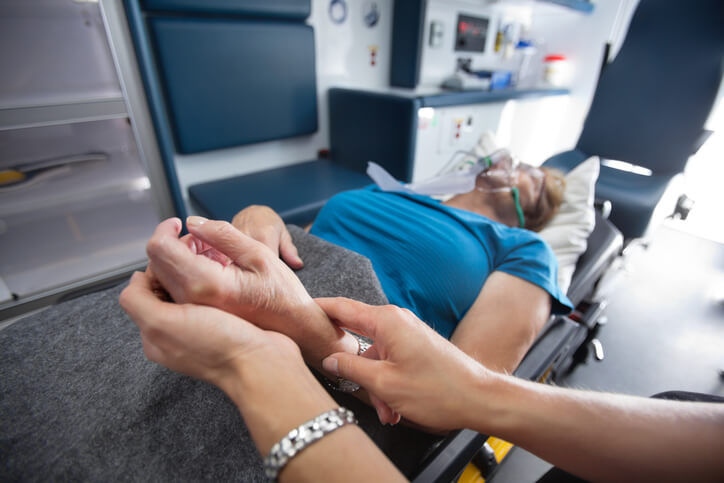
Respiratory emergencies among the elderly are common. As an emergency responder, especially if you work in warmer climes – such as Florida and Arizona – where many people go to retire, you will frequently be called upon to administer life-saving treatments for those in respiratory distress.
Here, we'll examine four common respiratory emergencies that you are likely to encounter among your older patients: pneumonia, chronic obstructive pulmonary disease (COPD), asthma, and lung cancer. Although lung cancer is considered a chronic, long-term illness, it can still precipitate a respiratory emergency. So, let's examine some of the signs and symptoms, risk factors, and ways of managing these common respiratory conditions.
Pneumonia
Pneumonia is a common ailment among geriatric patients, accounting for hundreds of thousands of hospital admissions each year. It is caused by viruses or other infectious agents, such as Streptococcus pneumonia and Staphylococcus aureus, which are common in nursing homes.
Signs and symptoms of pneumonia include:
- Fever
- Delirium
- Tachypnea
- Productive cough
- Malaise
- Failure to thrive
There are several risk factors for pneumonia. Age is one of the most common factors, with mortality increasing as the patient ages. Other risk factors for pneumonia include:
- Viral infections
- Heart failure
- Liver disease
- Influenza
- Lung disease
If any of the above conditions lead to the patient developing pneumonia, the pneumonia is considered a comorbidity.
Some conditions place the patient at risk for aspiration pneumonia, such as:
- Dysphagia (or any condition that results in difficulty swallowing, such as stroke)
- Gastroesophageal reflux disease
- Diabetes
Whenever the patient has an underlying condition that predisposes them to aspiration, they are at risk for developing pneumonia, so protect the airway diligently in such patients. Be especially mindful of male patients, who are more susceptible to the above conditions.
COPD
Chronic obstructive pulmonary disease (COPD) has a high incidence in the elderly, with at least 10% of people over the age of 65 diagnosed in the U.S. Symptoms include:
- Cough
- Chronic sputum production
- Wheezing
- Dyspnea
As with pneumonia, most patients with COPD suffer from comorbidities, such as congestive heart failure, hypertension, lung cancer, and stroke. Another similarity between pneumonia and COPD is that age is a common factor in COPD.
However, the primary risk factor for developing COPD is not age, but smoking, especially in those who currently smoke or who smoke 20 packs or more per year. Other risk factors include:
- Environmental exposure to biomass smoke
- Occupational exposures
- Certain gene mutations
- Prior tuberculosis infection
Asthma
We tend to think of asthma sufferers as younger, but the elderly are also frequently afflicted, with many diagnosed after the age of 50. Asthma can be difficult to differentiate from COPD in geriatrics, but they will typically present with:
- Chest tightness
- Wheezing
- Dyspnea at rest
- Morning phlegm
- Chronic cough
Many of these symptoms worsen at night and can appear in varying durations. Some factors that may help differentiate asthma from COPD in the elderly include the presence of trigger factors, a lack of smoking, childhood-onset, and episodic wheezing. Risk factors include comorbid diseases and obesity, and the condition's symptoms can be complicated by gastroesophageal reflux disease.
Lung Cancer
Although lung cancer is considered a chronic disease, it can still cause respiratory emergencies, especially among the elderly, who make up a majority of those diagnosed. As with pneumonia and COPD, the incidence of lung cancer increases with age, especially beyond 60; the median age of diagnosis is 70 years old.
Symptoms associated with lung cancer are considered nonspecific, but include:
- Chest pain
- Cough
- Difficulty breathing
- Hoarseness
- Hemoptysis
Smoking is the primary factor for diagnosis, though about 20% of those diagnosed have never smoked. Other risk factors include:
- Secondhand smoke
- Environmental exposures
- Radon
- Radiation therapy
Some conditions increase the risk of developing lung cancer, including HIV infection, COPD, family history, and pulmonary fibrosis.
The Role of Suction in Geriatric Respiratory Emergencies
Treating respiratory emergencies in the elderly includes establishing a patent airway, providing supplemental oxygen, drug therapy (when indicated), and the placement of an advanced airway when necessary.
Suction plays a pivotal role in managing respiratory emergencies in patients of any age. Removing blood, saliva, vomit, and clots from the airway restores patency, allows for visualization of the cords during intubation, and maintains a clear pathway for air exchange.
In patients suffering from pneumonia, asthma, COPD, or lung cancer, keeping the airway clear via suction will stabilize—and may even save—an elderly person having a respiratory emergency.
Editor's Note: This blog was originally published in May 2018. It has been re-published with additional up-to-date content.
















